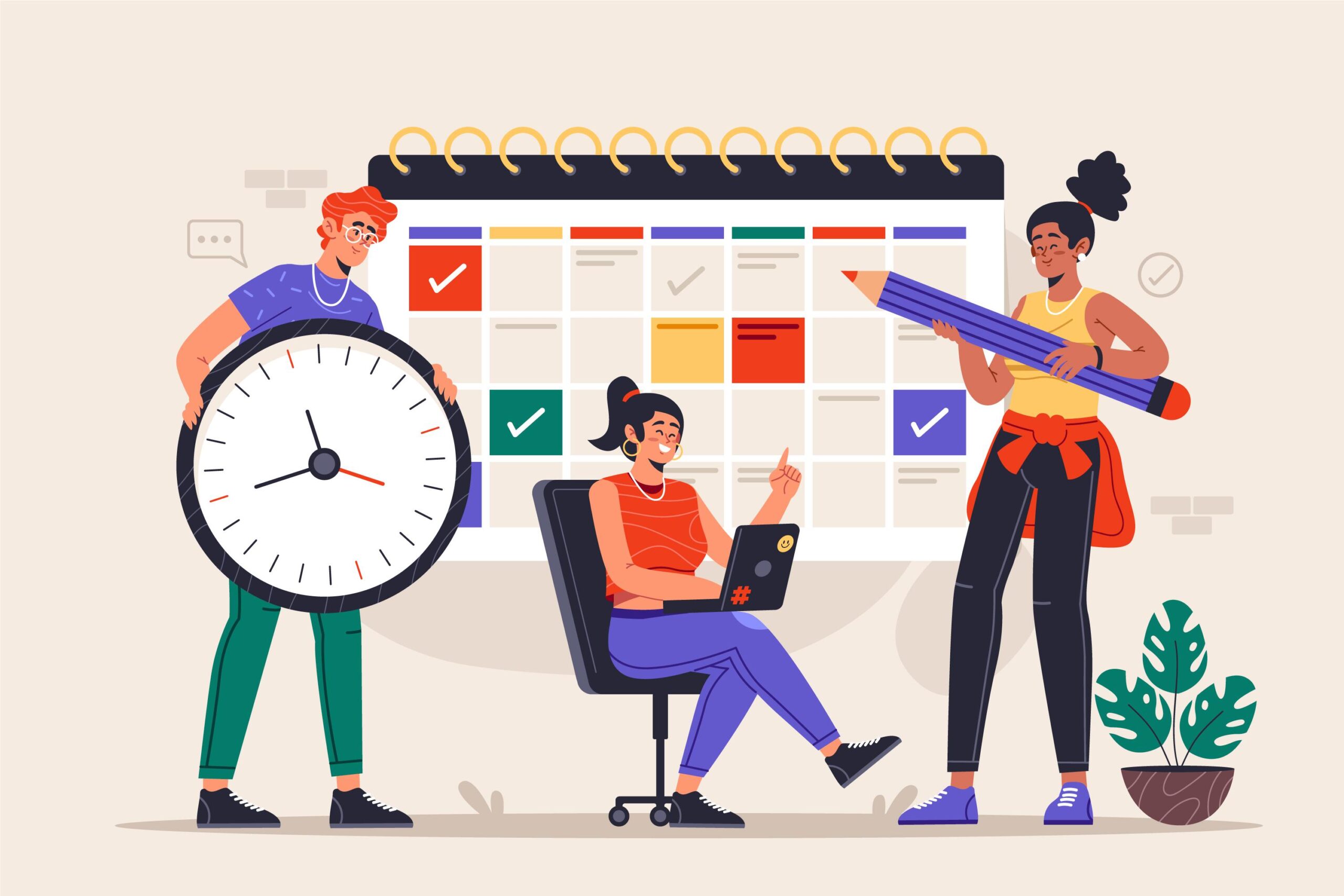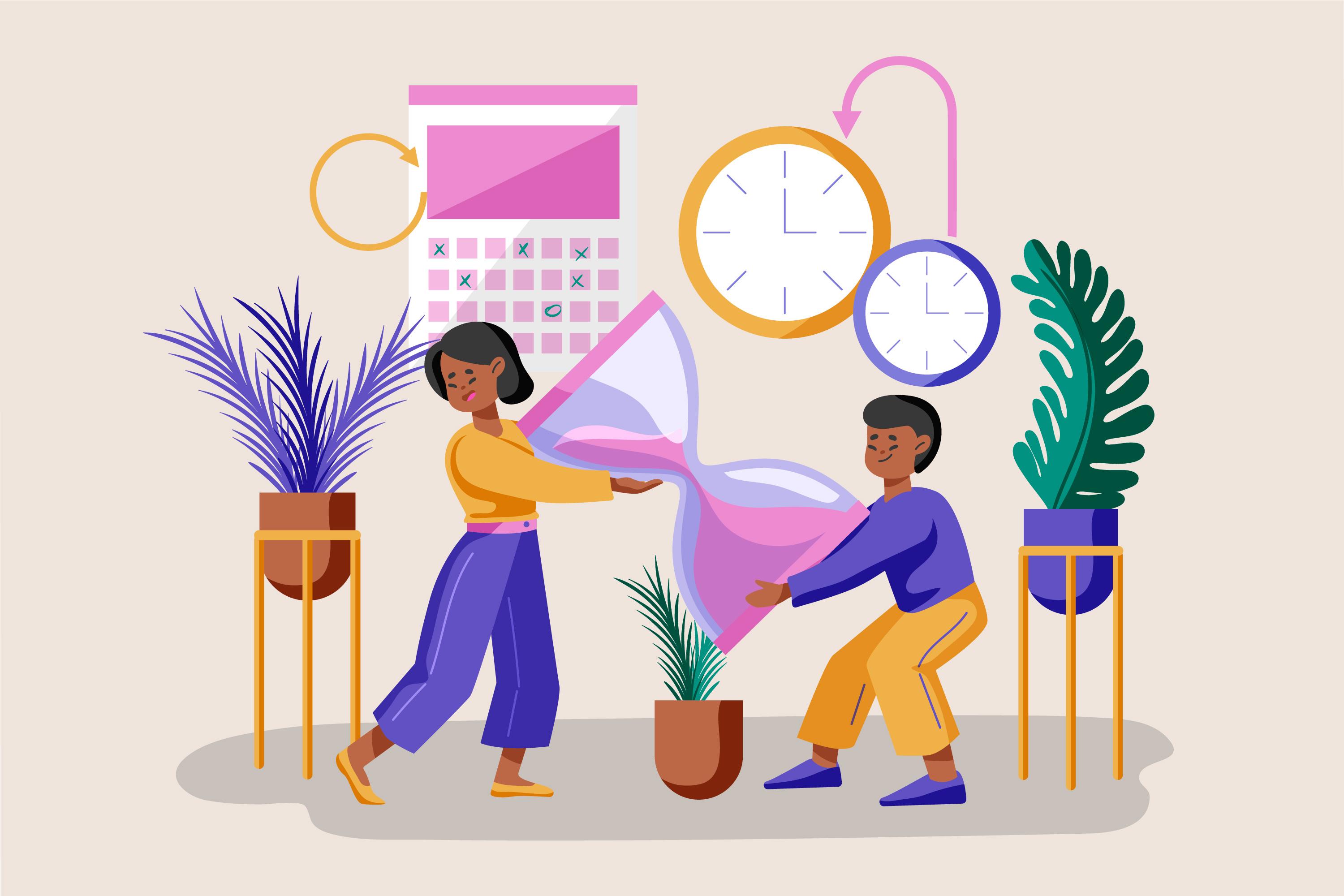
Learning goal: The goal of this lesson is to explore and evaluate various strategies, tools, and resources to manage your time and possible resulting stress.
If you followed Lesson 1, you have already identified and reflected on your potential stressors and time management habits, as well as your personal goals, values, and priorities. In Lesson 2, you were able to get some insights into some key theoretical models of time management. If you haven’t done so yet, have a look at Lesson 1 and Lesson 2 first. Otherwise, you are now ready for the next step: Finding the right tools and strategies that help you manage your time, find a structure, prevent procrastination, and relieve stress.
In case you are interested in tackling a specific problem, feel free to jump to the section presenting the right corresponding tool. The resources presented in this lesson include:
- Finding a structure and organizing: Eisenhower matrix, study plans, Trello, Notion
- Time tracking and planning ahead: Google Calendar, time blocking
- Time management and working productively: Pomodoro, study with me, study groups
- Stress prevention and relief: yoga online, relaxation techniques, podcasts, guided meditation, self-care checklists, sports classes
Finding a Structure and Organizing
An important first step in managing your time and preventing stress from breaking out is to organize and prioritize your tasks and goals. There are various ways in which you can tackle this, which can help you find a structure in the chaos and figure out how to divide your time and, even more importantly, how to start.
The Eisenhower Matrix, as mentioned in Lesson 2, can be helpful for figuring out your priorities and sorting tasks by urgency and importance. If you struggle with knowing where to start, it can help knowing which tasks need to be done most quickly, which you can do later, which you can potentially ask other people to help you with, and which may not be necessary to even follow.
Simply divide your tasks by sorting them into the four quadrants of the Eisenhower matrix:
If you have a lot of to-dos coming up, such as an intense exam period, this can be very overwhelming. It can help to make a study/task plan in this case. The Eisenhower Matrix can be useful to do some first sorting and prioritizing of your tasks – after that, a study plan can be useful to temporarily sort the important tasks further, listing all your to-dos into little steps and sorting them over the time period that you have. Pro-tip: also plan enough active breaks and leave enough buffer time in the end to prevent stress if something takes longer than expected – the earlier you start planning, the better!
You can make your study plan either old-school with pen and paper (or pre-made to-do lists or calendars, if you prefer this, e.g. from Hema), on note-taking apps or programs, or on specific apps for making to-do lists (e.g., Todoist).
Two special suggestions for planning and structuring your tasks are Trello and Notion. Trello is a productivity application that allows you to keep all your to-dos in one space, connect the program with e-mail and messaging services such as Teams or Slack to automatically import new to-dos or connect with friends – make planning easier. Similarly, Notion is an AI-powered workspace combining planning and performing your tasks. Within this free workspace, you can connect several programs, take and keep your notes in one place, make checklists, plans, and keep an overview of all your to-dos.
Time Tracking and Planning Ahead
Having planned your tasks sufficiently, it is on you to plan ahead and track your time to keep on top of everything. Time blocking, as described in Lesson 2, can be useful to boost productivity by dividing your day into different time blocks dedicated to a specific task or activity each. Make sure to take into account your own energy levels throughout the day when planning ahead and stay realistic. Do not overschedule, but instead mindfully plan focus blocks in which you concentrate on a certain task. This can help you regain a sense of control over your time and resources and get into a state of flow during work periods. Make sure to also schedule enough (active) breaks.
Google calendar is one of many useful online calendar tools that can help you keep an overview of your time management and put time blocking into practice. Simply fill the time blocks for the corresponding tasks for the day into the calendar, you can have the application on any device to keep your plan with you and always have insight into the scheduled time blocks.

Time Management and Working Productively
Your tasks are structured and organized, your day is planned into time blocks – now time to get to work! But how to stay productive during your scheduled work blocks?
The Pomodoro Technique can help stay focused by switching time intervals of focused work with short breaks. Usually, the time is divided into 25 minutes of work followed by 5 minutes of break time. This can help keep the mind focused during the productive 25 minutes and keep better track of how time is spent working instead of procrastinating. Regular breaks can also help keep your stress level low, prevent fatigue and keep up motivation. Pomodoro timer apps or Pomodoro YouTube videos can help keep track of the time.
Alternatively, it can help to have company while studying, to have a feeling of accountability for what you are getting done. Starting a study group with friends or fellow students/colleagues can be useful for some people, to keep each other motivated and possibly even help with any upcoming questions during study – of course this is only of use if you and your study buddies do not distract each other and have them same expectations for your joined study sessions. If you struggle with being distracted when studying with other people, but still like the feeling of not studying alone, “Study with me” videos on YouTube could be an idea for you, to motivate you and provide you with a feeling of company during long study sessions.
Stress Prevention and Relief
To prevent stress or relieve yourself from it, if it has already taken over, it is important to take care of yourself and schedule enough time for active breaks. Self-care can take many forms and can easily be performed both outside and in the comfort of your own home.
Self-care is often connected to mindfulness, which starts with taking active breaks and being aware of your own mental state and feelings. If you struggle with this, you could try some simple, easily accessible tools to practice mindfulness. Many of these resources can be found online, in the form of for example self-care podcasts or guided meditation. To start, you could also try looking at self-care checklists (see e.g. Canva for templates), to make sure you take care of yourself and integrate some easy habits into your daily routine: taking a small guided meditation break in the morning, going on a walk after lunch, or writing down one good thing of the day after a long day of work.
Moving your body is another great way for stress prevention and relieve. If you do not have any in-person resources at hand or are unable to participate in such, online workout classes that you can follow at home could be an option for you. Try for example yoga videos, a great combination of physical activity and mindfulness. Otherwise, check out sports classes near you – this can help you get out of the house, meet other people, and get your mind off work while doing something good for yourself. If you are a student of the University of Groningen, check out ACLO for affordable sports classes (many universities have similar sports offers that may be worth a try).
Task:
Now that we have presented many easily accessible resources for you to improve your time and stress management skills, we want you to get into it! Explore at least two of the resources presented here and look into why and how you want to apply them. In Lesson 4, we help you put theory into practice!